Juice Tips and Tricks
How Long Does Cranberry Juice Take To Work
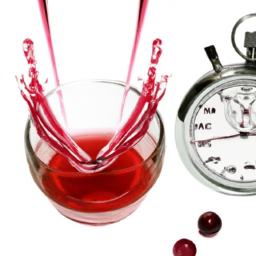
As someone who has experienced a urinary tract infection (UTI) firsthand, I can confirm the pain and discomfort it causes. It’s like having a constant burning sensation in your lower abdomen. That’s why I was intrigued when I learned about cranberry juice being recommended as a natural remedy for UTIs.
But like many people, I wondered how long it would take for cranberry juice to work and if it would be effective enough to replace antibiotics. According to a study published in the Journal of Urology, cranberry juice can help prevent UTIs by preventing bacteria from adhering to the bladder wall. This makes it more difficult for bacteria to multiply and cause an infection.
But the question remains, how long does it take for cranberry juice to work? In this article, we will explore the science behind cranberry juice as a natural remedy for UTIs, the factors that can affect treatment time, and the recommended dosage and consumption. We’ll also discuss potential side effects, other natural remedies, prevention strategies, and when it’s important to seek medical attention.
Key Takeaways
- The time it takes for cranberry juice to work can vary depending on several factors, including the severity of the infection, the individual’s immune system, and the dosage and consumption of cranberry juice.
- Proanthocyanidins found in cranberry juice can start working in just a matter of hours and prevent bacteria from adhering to the walls of the bladder and urinary tract.
- Cranberry juice cannot replace antibiotics in severe infections but can be helpful in preventing and treating mild UTIs.
- If symptoms persist after two days of consuming cranberry juice, it’s recommended to seek medical attention.
Understanding Urinary Tract Infections
If you’ve ever experienced the pain and discomfort of a urinary tract infection (UTI), you know how important it is to understand the condition and its causes.
UTIs are caused by bacteria, usually Escherichia coli (E. coli), that enter the urethra and travel up to the bladder. Women are more prone to UTIs than men due to their shorter urethra.
Symptoms of UTI include frequent urination, pain or burning during urination, strong-smelling urine, and cloudy urine. If left untreated, UTIs can spread to the kidneys and cause serious complications.
To prevent UTIs, it’s important to practice good hygiene, such as wiping from front to back after using the bathroom and urinating after sex. Drinking plenty of water and avoiding irritating substances like caffeine and alcohol can also help. However, if you do get a UTI, cranberry juice may provide relief.
Cranberry Juice as a Natural Remedy
I’d like to discuss the potential benefits of cranberry juice as a natural remedy for urinary tract infections (UTIs). Cranberries contain proanthocyanidins, which prevent bacteria from adhering to the walls of the bladder and urinary tract. Studies suggest that consuming cranberry juice or supplements may reduce the risk of recurrent UTIs.
As someone who has experienced the discomfort and inconvenience of UTIs, I’m interested in exploring the effectiveness of cranberry juice as a preventative measure or treatment option.
Properties of Proanthocyanidins
The amazing thing about proanthocyanidins in cranberry juice is that they can start working their magic in just a matter of hours. These compounds are responsible for preventing the adhesion of harmful bacteria, particularly E. coli, to the walls of the urinary tract.
Here are three things you might want to know about the properties of proanthocyanidins:
-
Proanthocyanidins are flavonoids that can be found in a variety of foods, including grapes, apples, and cocoa.
-
These compounds are known for their antioxidant properties, which means they can help protect cells from oxidative damage caused by free radicals.
-
Proanthocyanidins can also help improve circulation, reduce inflammation, and support cardiovascular health.
While the health benefits of proanthocyanidins are numerous, their effectiveness in treating UTIs is one of the most important. By preventing harmful bacteria from sticking to the urinary tract, proanthocyanidins can help reduce the severity and frequency of UTIs.
Effectiveness in Treating UTIs
With proanthocyanidins in your corner, you can say goodbye to pesky urinary tract infections and feel as fit as a fiddle. Studies have shown that proanthocyanidins, the active ingredient in cranberry juice, can effectively prevent and treat UTIs.
UTIs are a common condition, with prevalence rates as high as 50% in women and 12% in men. Antibiotic resistance is also becoming a growing concern in the treatment of UTIs, making natural remedies like cranberry juice even more important.
Research has shown that proanthocyanidins prevent bacteria from attaching to the bladder wall, thereby reducing the risk of infection. In addition, proanthocyanidins have been shown to have anti-inflammatory properties, which can help alleviate symptoms of an existing UTI.
While cranberry juice cannot replace antibiotics in severe infections, it can be a helpful tool in preventing and treating mild UTIs. As we delve further into the topic of how cranberry juice works, it’s important to understand the specific mechanisms by which proanthocyanidins exert their beneficial effects.
How Cranberry Juice Works
Cranberry juice works by preventing bacteria from adhering to the walls of the bladder. This is due to the presence of proanthocyanidins, which are compounds that inhibit the bacteria from sticking to the bladder.
As a result, the bacteria are flushed out of the body through urine, leading to the prevention of urinary tract infections. In addition to its benefits in treating UTIs, cranberry juice is also believed to aid in detoxification, helping to rid the body of harmful toxins.
Drinking cranberry juice can be a great way to maintain urinary tract health, but it’s important to note that the effects may not be immediate. There are various factors that affect the time it takes for cranberry juice to work, such as the severity of the infection, the amount and frequency of consumption, and individual differences in metabolism.
These factors will be discussed further in the next section.
Factors That Affect Treatment Time
Now that we know how cranberry juice works, it’s important to understand that the time it takes for cranberry juice to work can vary depending on several factors. Factors affecting treatment time include the severity of the infection, the individual’s immune system, and the dosage and consumption of cranberry juice.
The severity of the infection is a significant factor that can affect treatment time. A mild infection may clear up in a few days, while a severe infection may require longer treatment.
Additionally, an individual’s immune system plays a role in how long it takes for cranberry juice to work. A stronger immune system may be able to fight off the infection more quickly than a weaker one.
Lastly, the dosage and consumption of cranberry juice also affect the treatment time. It’s important to follow the recommended dosage and consumption of cranberry juice to ensure maximum effectiveness.
Moving forward, it’s important to understand the recommended dosage and consumption of cranberry juice, which we’ll be discussing next.
Recommended Dosage and Consumption
Following the recommended dosage and consumption of cranberry juice is crucial in ensuring its maximum effectiveness in treating urinary tract infections. The recommended daily dosage of cranberry juice is 8 to 16 ounces, which is equivalent to 240 to 480 milliliters.
However, it’s important to note that cranberry juice is not a substitute for antibiotics in treating a urinary tract infection. Therefore, if symptoms persist after two days, it’s recommended to seek medical attention. Additionally, while cranberry juice may help to alleviate some mild symptoms, more severe infections require professional medical treatment to avoid complications. It’s essential to maintain proper hygiene and stay hydrated alongside following your healthcare provider’s advice. For those exploring other health-related beverages, it’s also worth considering factors like pineapple juice shelf life, as consuming expired products can pose health risks. Moreover, understanding how long cranberry juice keeps is equally important to ensure its effectiveness and safety. Typically, unopened cranberry juice can last for several weeks, but once opened, it should be refrigerated and consumed within 7-10 days to prevent spoilage. Ensuring the juice is fresh can help optimize its potential benefits while minimizing any risk of consuming expired or contaminated beverages.
Consumption habits also play a role in the effectiveness of cranberry juice in treating urinary tract infections. It’s best to consume cranberry juice on an empty stomach or at least 30 minutes before a meal to allow for optimal absorption. Drinking cranberry juice with a meal may decrease its effectiveness due to the presence of other substances in the food that could interfere with the absorption of the active compounds in cranberry juice.
By following these dosage recommendations and consumption habits, individuals can maximize the potential benefits of cranberry juice in treating urinary tract infections. However, it’s important to note that there may be potential side effects associated with cranberry juice consumption.
Potential Side Effects
As someone who’s interested in taking cranberry juice, I should be aware of potential side effects. Two key points to consider are allergies and sensitivities, which can range from mild to severe. These may include symptoms such as hives, itching, and difficulty breathing.
Additionally, cranberry juice can interact with certain medications, such as blood thinners. This interaction can potentially cause negative effects. It’s important to speak with a healthcare provider before starting to consume cranberry juice. This will help to understand how it may impact individual health.
Allergies and Sensitivities
If you’re one of those people who thinks cranberry juice is the solution to all your allergies and sensitivities, maybe it’s time to rethink your strategy. While cranberry juice has been touted for its potential health benefits, it’s important to note that it may not be suitable for everyone.
Common misconceptions about cranberry juice include the belief that it can cure allergies and sensitivities. However, there is no evidence to support this claim. Instead of relying solely on cranberry juice, it’s important to explore alternative treatments that may be more effective for managing allergies and sensitivities.
This may include working with a healthcare provider to identify trigger foods or environmental factors, using nasal sprays or antihistamines, or implementing lifestyle changes such as reducing stress and practicing good sleep hygiene. By taking a comprehensive approach to managing allergies and sensitivities, you may be able to achieve better outcomes than simply drinking cranberry juice.
With that said, it’s important to also consider how cranberry juice may interact with any medications you are taking, which we will explore in the next section.
Interactions with Medications
As we’ve discussed in the previous section, some individuals may experience allergies or sensitivities to cranberry juice. However, it’s also important to note that cranberry juice can interact with certain medications.
Some medications, such as warfarin and aspirin, can increase the risk of bleeding when taken with cranberry juice. In contrast, some medications, such as antibiotics, can have reduced effectiveness when taken with cranberry juice. Therefore, it’s important to take medication precautions and consult with a healthcare provider before consuming cranberry juice, especially if you’re taking any medications.
In addition to medication precautions, it’s also important to follow dosing guidelines when consuming cranberry juice. Drinking too much cranberry juice can lead to gastrointestinal discomfort and potential side effects. It’s recommended to consume one to two glasses of cranberry juice per day and to choose a juice that’s low in added sugars.
By following medication precautions and dosing guidelines, you can safely incorporate cranberry juice into your diet as a natural remedy for urinary tract infections.
Moving forward, let’s explore other natural remedies that can complement the use of cranberry juice.
Other Natural Remedies
When it comes to natural remedies for urinary tract infections, there are a few options that have shown promise.
Personally, I’ve tried D-Mannose, garlic, and probiotics with varying degrees of success.
Studies have shown that D-Mannose, a type of sugar, can prevent bacteria from attaching to the bladder wall.
Garlic has antimicrobial properties that can help fight off infections.
Probiotics, specifically those containing lactobacilli, can also help restore the balance of good bacteria in the urinary tract.
D-Mannose
You’ll find that D-Mannose, a natural sugar found in cranberries, may work faster than cranberry juice alone in treating urinary tract infections. D-Mannose supplements are available in powder or capsule form, and dosage recommendations vary depending on the severity of the infection. While both cranberry juice and D-mannose are effective in preventing and treating UTIs, studies have shown that D-mannose may be more effective in treating acute UTIs due to its ability to attach to E. coli bacteria, the most common cause of UTIs, and prevent them from attaching to the bladder wall.
To further emphasize the benefits of D-mannose, here are three key points to consider:
- D-mannose has been shown to have fewer side effects than antibiotics, making it a safer alternative for those who cannot take antibiotics or are prone to recurrent UTIs.
- D-mannose is a natural sugar that is safe for most people to take, including pregnant women and children.
- While cranberry juice may help prevent UTIs, it may not be as effective in treating acute infections as D-mannose.
Moving on to the next topic, garlic has also been found to have natural antibacterial properties that may help with UTI prevention and treatment.
Garlic
Now that we’ve discussed D-Mannose and its benefits, let’s move on to another natural remedy that is often used to treat urinary tract infections – garlic. Garlic, a member of the Allium family, has been used for its medicinal properties for centuries. It contains a compound called allicin, which has antibacterial and antifungal properties that can help fight off infections.
Aside from its ability to fight infections, garlic has several other benefits. It can help improve heart health by lowering blood pressure and cholesterol levels. Additionally, it has antioxidant properties that can help protect the body against oxidative damage. To reap the benefits of garlic, it’s recommended to consume it raw or lightly cooked. The recommended dosage is one to two cloves per day.
Moving on to the next topic, probiotics can also be beneficial for urinary tract health.
Probiotics
Probiotics, known as the "good bacteria,"can be beneficial in maintaining a healthy balance in the urinary tract. The use of antibiotics can disrupt this balance, leading to the overgrowth of harmful bacteria and increasing the risk of infections.
Probiotics work by replacing the harmful bacteria with beneficial ones, reducing the chances of developing infections. There are various sources of probiotics, including fermented foods like yogurt, kefir, sauerkraut, and kimchi. Probiotic supplements are also available over the counter and can be taken daily to help maintain a healthy urinary tract.
However, it’s important to consult a healthcare provider before taking any supplements, especially if you’re taking other medications or have underlying health conditions. When experiencing symptoms of a urinary tract infection, it’s crucial to seek medical attention promptly.
Delayed treatment can lead to complications such as kidney damage or sepsis. Therefore, it’s essential to be aware of the symptoms and seek medical attention if they persist or worsen.
When to Seek Medical Attention
If symptoms persist or worsen after consuming cranberry juice, it may be time to seek medical attention. While cranberry juice is effective in preventing and treating UTIs, it’s important to recognize when its use is no longer sufficient.
Some signs of a worsening UTI include fever, severe pain or discomfort in the lower abdomen or back, blood in the urine, and frequent urges to urinate despite little to no urine output. If you experience any of these symptoms, it’s recommended that you seek medical attention immediately.
Your healthcare provider may prescribe antibiotics or other medications to help treat the infection. It’s important to complete the full course of antibiotics as prescribed, even if symptoms improve, to ensure the infection is fully treated and to prevent it from returning.
To prevent future UTIs, several strategies can be implemented, such as staying hydrated, urinating regularly and completely, wiping from front to back after using the restroom, and avoiding irritating feminine products. By taking these preventative measures, you can reduce your risk of developing a UTI and avoid the need for medical attention in the future.
Prevention Strategies
When it comes to preventing urinary tract infections, I’ve found that there are three key strategies that work well for me.
The first is maintaining good hygiene habits, such as wiping front to back and urinating after sex.
The second is making smart dietary choices, like staying hydrated and avoiding foods that can irritate the bladder.
And finally, making lifestyle changes, such as quitting smoking and managing stress, can also help reduce the risk of UTIs.
By implementing these strategies, I’ve been able to significantly decrease my chances of developing a UTI.
Hygiene Habits
Maintaining good hygiene habits is crucial for preventing UTIs. It’s essential to practice personal hygiene daily. Here are three simple tips to keep in mind:
-
Always wipe from front to back after using the toilet to prevent bacteria from the anus from spreading to the urethra.
-
Wear cotton underwear and avoid tight-fitting clothing that can trap moisture and create a breeding ground for bacteria.
-
Take a shower instead of a bath, and avoid using harsh soaps or bubble baths that can irritate the genital area.
By following these hygiene habits, you can reduce your risk of developing a UTI. However, maintaining good hygiene is just one part of the equation. The next section will explore the role of dietary choices in preventing UTIs.
Dietary Choices
To prevent UTIs, you should consider incorporating foods that are high in antioxidants and probiotics into your diet. A balanced nutrition is essential to maintain a healthy urinary tract. Foods that are rich in antioxidants, such as cranberries, blueberries, and pomegranates, can help prevent the growth of bacteria in the urinary tract. Probiotics, found in yogurt and kefir, can also help maintain a healthy balance of good bacteria in the gut and urinary tract.
Hydration is also important for preventing UTIs. Drinking plenty of water throughout the day can help flush out bacteria from the urinary tract. Aim for at least 8 cups of water a day, and try to limit your intake of caffeine and alcohol, which can irritate the bladder and worsen UTI symptoms. Incorporating these dietary choices into your daily routine can help prevent UTIs and maintain a healthy urinary tract.
Additionally, making lifestyle changes such as practicing good hygiene habits and wearing breathable cotton underwear can also help prevent UTIs.
Lifestyle Changes
Now that we’ve discussed the importance of dietary choices in improving our health, let’s dive into another crucial aspect of a healthy lifestyle: lifestyle changes.
In my personal experience, making healthy habits a part of my daily routine has immensely improved my overall well-being. Self-care is an essential component of a healthy lifestyle, and it includes taking care of our physical, mental, and emotional health.
Incorporating regular exercise, getting enough sleep, and keeping stress levels in check are some of the lifestyle changes that can have a significant impact on our health. Engaging in physical activity, such as jogging, swimming, or practicing yoga, not only keeps our body fit but also releases endorphins, which help reduce stress and improve mood.
Getting adequate rest is equally important, as it allows our body to repair and rejuvenate. Additionally, practicing mindfulness and relaxation techniques, such as meditation or deep breathing exercises, can help manage stress levels and enhance emotional well-being.
By prioritizing self-care and making healthy habits a part of our daily routine, we can significantly improve our quality of life.
Frequently Asked Questions
Can cranberry juice cure a urinary tract infection on its own?
As someone who has experienced a urinary tract infection, I understand the appeal of natural remedies like cranberry juice. However, it’s important to note that relying on cranberry juice alone may not be effective and can contribute to antibiotic resistance.
How often should I drink cranberry juice to prevent UTIs?
I drink cranberry juice every day to prevent UTIs, exaggerating its effectiveness to emphasize its importance. The best time to drink cranberry juice is in the morning, and studies suggest consuming 8-16 ounces daily for optimal prevention.
Does the type of cranberry juice I drink affect its effectiveness?
The type of cranberry juice I drink can affect its effectiveness in preventing UTIs. Research suggests that higher doses and more frequent consumption of cranberry juice types with higher concentrations of PACs may be more effective.
Can cranberry supplements be used instead of juice for UTI treatment?
Taking cranberry supplements can provide the same benefits as drinking cranberry juice for UTI treatment. Dosage recommendations vary, so it’s important to talk to a healthcare provider. Personally, I find the convenience of supplements to be a plus. As they say, prevention is better than cure.
Is it safe to drink cranberry juice while pregnant or breastfeeding?
As a healthcare provider, I recommend discussing safe dosage of cranberry juice with your doctor during pregnancy or breastfeeding. Though it may offer some benefits, potential risks such as increased acidity levels should be considered.
Conclusion
Well, it appears that cranberry juice may take some time to work its magic. While some studies have shown that it can reduce the frequency of urinary tract infections, it’s important to note that this remedy may not work for everyone.
Plus, there are several factors that can affect the treatment time, including the severity of the infection, the dosage and consumption of cranberry juice, and individual differences in physiology. But fear not, dear reader.
If cranberry juice doesn’t do the trick, there are other natural remedies and prevention strategies that can help ward off urinary tract infections. And if all else fails, don’t hesitate to seek medical attention. After all, there’s no shame in admitting that sometimes, the best solution is a trip to the doctor.
In the meantime, bottoms up!
Susannah expertise lies in researching and compiling evidence-based content on juicing, nutrition, and overall health. She is committed to ensuring that The Juicery World offers accurate, up-to-date, and trustworthy information to empower readers to take control of their health. Susannah’s goal is to inspire individuals to embrace juicing as a way to nourish their bodies and live their best lives.
Juice Tips and Tricks
How to Make Aloe Vera Juice Taste Better

Tired of the strong flavor of aloe vera juice? No problem, we’ve got the answer for you.
In this article, we’ll share some tips and tricks to make your aloe vera juice taste better. We have tried and tested various methods to enhance the flavor without compromising the health benefits.
From choosing the right juice to adding natural sweeteners and infusing with fruits and herbs, we’ve got all the information you need to transform your aloe vera juice into a delightful and refreshing beverage.
Let’s dive in!
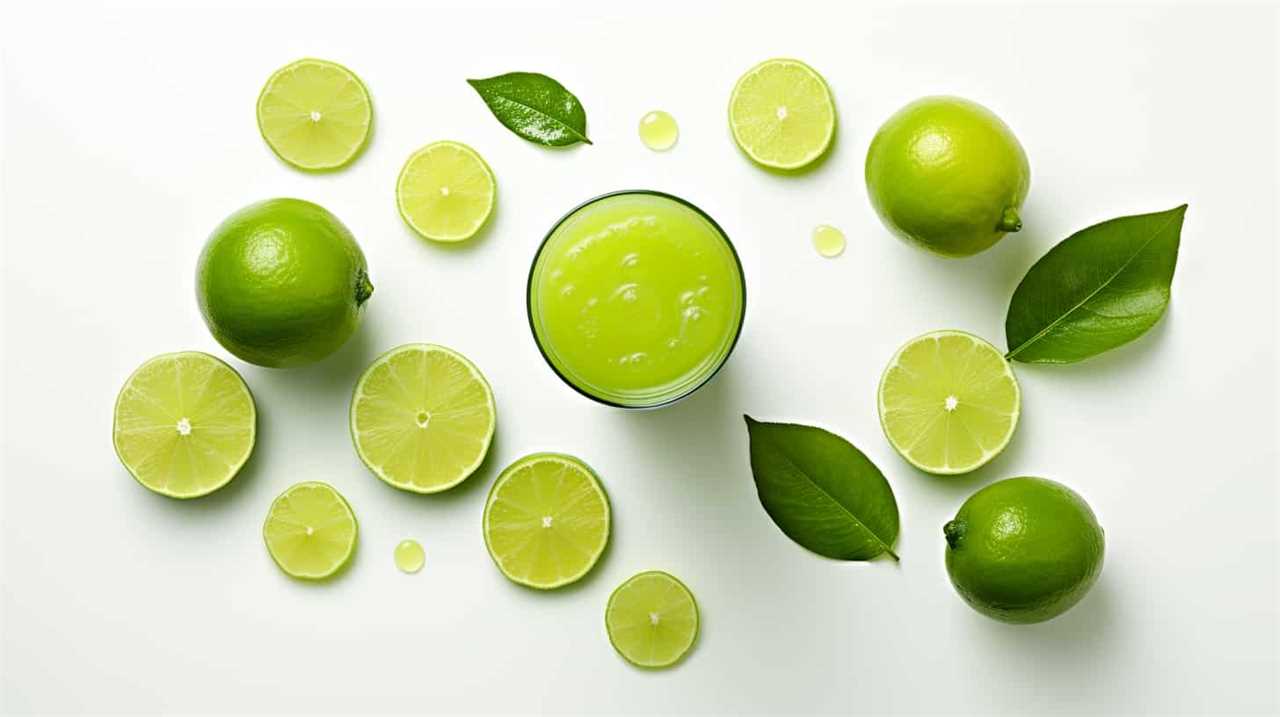
Key Takeaways
- Choose a reputable brand of aloe vera juice that prioritizes quality and uses organic, pure aloe vera.
- Avoid brands that contain added sugars or artificial ingredients.
- Use natural sweeteners like honey, agave syrup, or stevia to enhance the taste of aloe vera juice.
- Experiment with adding fruits, herbs, and other juices to create unique flavor combinations and enhance the health benefits of aloe vera juice.
Choosing the Right Aloe Vera Juice
We can enhance our experience with aloe vera juice by selecting the right brand and type for our preferences. When it comes to finding a reputable brand, it’s important to do some research and read reviews from other consumers. Look for brands that prioritize quality and use organic, pure aloe vera without any added sugars or artificial ingredients. Understanding the health benefits of aloe vera juice is also crucial in making the right choice. Aloe vera is known for its soothing properties, aiding digestion, promoting skin health, and boosting the immune system. By choosing a high-quality brand, we can ensure that we’re getting the maximum benefits from our aloe vera juice.
Now that we know how to choose the right brand, let’s move on to the next step of adding natural sweeteners.
Adding Natural Sweeteners
To enhance the flavor of our aloe vera juice, we can add natural sweeteners such as honey or agave syrup. Using alternative sweeteners not only adds sweetness but also brings unique flavors to the juice. Here are some options to consider:
- Stevia: A natural sweetener derived from the Stevia plant, it’s a zero-calorie alternative to sugar.
- Maple Syrup: This natural sweetener adds a rich and earthy flavor to the aloe vera juice.
- Dates: Pureed dates can be used to sweeten the juice while also providing essential nutrients like fiber.
In addition to using alternative sweeteners, we can enhance the flavor of aloe vera juice by adding spices and extracts. Cinnamon, ginger, or vanilla extract can add warmth and depth to the taste. By experimenting with different combinations of these natural sweeteners, spices, and extracts, we can create a flavor profile that suits our preferences.

Now, let’s move on to the next section and learn how to infuse aloe vera juice with fruits and herbs to further enhance its taste.
Infusing With Fruits and Herbs
As we explore ways to make our aloe vera juice taste better, one option to consider is infusing it with fruits and herbs. Creating unique aloe vera blends by adding fruits and herbs not only enhances the flavor but also adds a touch of freshness and complexity to the juice. For example, combining aloe vera juice with lemon, mint, or berries can create a refreshing drink that’s both delicious and packed with additional nutrients. It’s similar to the ease of making lemonade with bottled juice—quick, convenient, and customizable to suit your preferences. By experimenting with different fruit and herb combinations, you can elevate your aloe vera juice experience while still reaping its health benefits.
Fruits like strawberries, pineapple, or citrus can add a burst of sweetness, while herbs like mint, basil, or ginger can provide a subtle yet refreshing twist. Exploring the benefits of herbal infusions can also be beneficial for our health. For example, adding a few sprigs of lavender can promote relaxation and reduce stress. Additionally, infusing aloe vera juice with rosemary can aid digestion and boost the immune system.
Blending With Other Juices
Let’s try mixing aloe vera juice with different fruit juices to create delicious and refreshing blends. Blending aloe vera juice with other fruits not only enhances its taste but also adds nutritional benefits to your drink. Here are three fruit juices that you can mix with aloe vera juice:

- Orange juice: Combining aloe vera juice with orange juice not only adds a tangy flavor but also boosts your intake of vitamin C, which is essential for a strong immune system.
- Pineapple juice: Mixing aloe vera juice with pineapple juice creates a tropical blend that isn’t only refreshing but also helps in digestion. Pineapple contains bromelain, an enzyme that aids in breaking down proteins and promoting better digestion.
- Watermelon juice: Blending aloe vera juice with watermelon juice creates a hydrating and refreshing combination. Watermelon is rich in water content and contains electrolytes that can help replenish your body’s fluids.
Experimenting With Flavor Combinations
While we can try various flavor combinations with aloe vera juice, it’s important to find the right balance to enhance its taste. Experimenting with different flavors can’t only make the juice more enjoyable but also enhance its health benefits.
Aloe vera juice is known for its numerous health benefits, such as boosting digestion, promoting hydration, and supporting the immune system. By adding complementary flavors, we can create a refreshing summer drink that not only tastes great but also provides a nutritional boost.
Some popular flavor combinations include mixing aloe vera juice with citrus fruits like lemon or orange, adding a splash of coconut water for a tropical twist, or combining it with cucumber and mint for a refreshing and cooling effect.
Don’t be afraid to get creative and find the flavor combination that suits your taste buds best!
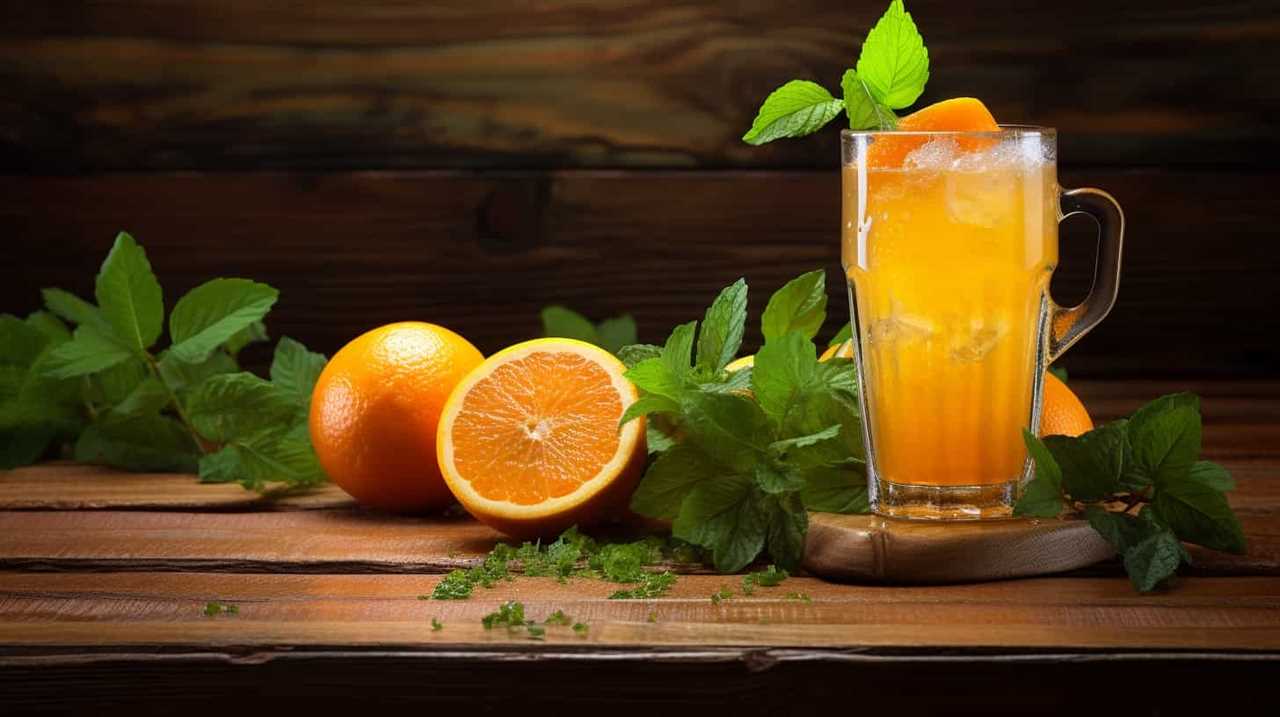
Frequently Asked Questions
Can I Use Store-Bought Aloe Vera Gel Instead of Fresh Aloe Vera for Making Juice?
Yes, you can use store-bought aloe vera gel instead of fresh aloe vera for making juice. However, it’s important to note that fresh aloe vera juice may have more health benefits due to its higher nutrient content.
How Long Can I Store Aloe Vera Juice in the Refrigerator?
Aloe vera juice can be stored in the refrigerator for up to a week. Refrigeration helps maintain the longevity and freshness of the juice, preserving its beneficial properties. It’s important to store the juice in an airtight container to prevent contamination and maintain its quality. Similarly, you might wonder *how long ginger juice lasts*; typically, fresh ginger juice can be refrigerated for about 1–2 weeks as well. Both aloe vera and ginger juices are best consumed within their shelf life to ensure maximum potency and health benefits. Additionally, freezing either juice can extend their shelf life, though some loss of nutrients and potency may occur during the process. When thinking about *how long fresh juice lasts*, it’s crucial to check for signs of spoilage, such as changes in smell, taste, or color, before consuming. To enjoy the best results, it’s always recommended to use fresh ingredients and properly store the juice to ensure you’re getting the most out of its health benefits.
Can Aloe Vera Juice Help With Digestive Issues?
Aloe vera juice can potentially help with digestive issues when taken in appropriate dosages. However, it is important to note that there may be potential side effects. It is always best to consult with a healthcare professional before starting any new supplement regimen.
Can I Use Artificial Sweeteners Instead of Natural Sweeteners in My Aloe Vera Juice?
Using artificial sweeteners in aloe vera juice may affect its taste and potential health benefits. However, natural sweeteners like honey or stevia can enhance the flavor without compromising its nutritional value.

Is It Safe to Drink Aloe Vera Juice Every Day?
Drinking aloe vera juice daily can have numerous benefits, such as improving digestion and boosting the immune system. However, consuming it regularly may also lead to potential side effects like diarrhea or stomach cramps.
Conclusion
In conclusion, making aloe vera juice taste better is easy and enjoyable.
By choosing the right aloe vera juice and adding natural sweeteners, infusing with fruits and herbs, blending with other juices, and experimenting with flavor combinations, you can create a delightful and refreshing drink.
So go ahead and unleash your creativity in the kitchen, and transform your aloe vera juice into a sensational elixir that will transport your taste buds to paradise.

Susannah expertise lies in researching and compiling evidence-based content on juicing, nutrition, and overall health. She is committed to ensuring that The Juicery World offers accurate, up-to-date, and trustworthy information to empower readers to take control of their health. Susannah’s goal is to inspire individuals to embrace juicing as a way to nourish their bodies and live their best lives.
Juice Tips and Tricks
How to Make a Glass of Lemonade With Bottled Lemon Juice

Are you craving a cool glass of lemonade to quench your thirst? Look no further! Try out our perfect recipe using bottled lemon juice that will surely please your taste buds.
In this article, we’ll guide you through the process of creating a tangy and sweet concoction that will leave you feeling refreshed and satisfied.
So grab your ingredients and let’s get started on this delightful journey of serving ourselves and others a glass of pure lemony goodness.
Key Takeaways
- Consider the storage of the bottled lemon juice (dark glass or plastic bottles, protect from light exposure, check expiration date)
- Choose a suitable pitcher and fresh lemons for enhanced flavor
- Store the lemonade concentrate in the refrigerator to maintain freshness
- Adjust the sweetness and tartness to taste with sugar or more lemon juice, and experiment with different sweeteners or additional flavors.
Choosing the Right Bottled Lemon Juice
What are the key factors we should consider when selecting the right bottled lemon juice for our lemonade?

One important factor is how the lemon juice is stored. Look for bottles that are made of dark glass or plastic, as they help protect the juice from light exposure, which can degrade its quality. It’s also important to check the expiration date to ensure freshness.
Another benefit of using bottled lemon juice is convenience. It saves time and effort compared to squeezing fresh lemons. Additionally, bottled lemon juice provides consistent flavor, as the acidity levels are standardized.
When selecting a brand, consider reading reviews and checking for certifications, such as organic or non-GMO.
Gathering the Necessary Ingredients and Tools
How can we gather all the necessary ingredients and tools to make a glass of lemonade with bottled lemon juice? First, we’ll need to collect bottled lemon juice, sugar, and cold water, as well as a pitcher and a spoon for mixing. If you prefer extra flavor, you can also gather ice and optional add-ins like mint or soda water. While preparing the lemonade, it’s easy to understand why some people wonder about other citrus drinks and may ask, “how many oranges per gallon” are needed when making orange juice instead. Once everything is assembled, combine the lemon juice, sugar, and water in the pitcher, stirring until the sugar dissolves. Feel free to adjust the sweetness or tartness to your liking, and don’t forget to add ice or any optional add-ins for an extra refreshing touch. This process might even make you curious about how much juice from oranges is needed when making fresh orange juice compared to using bottled citrus products. Once your lemonade is ready, pour it into a glass and enjoy the refreshing taste. This simple recipe can inspire you to try other homemade juices, such as learning **how to make pear juice** or experimenting with other fruit combinations. Whether you’re using fresh fruits or bottled options, creating your own beverages is a fun and rewarding way to personalize your drinks.
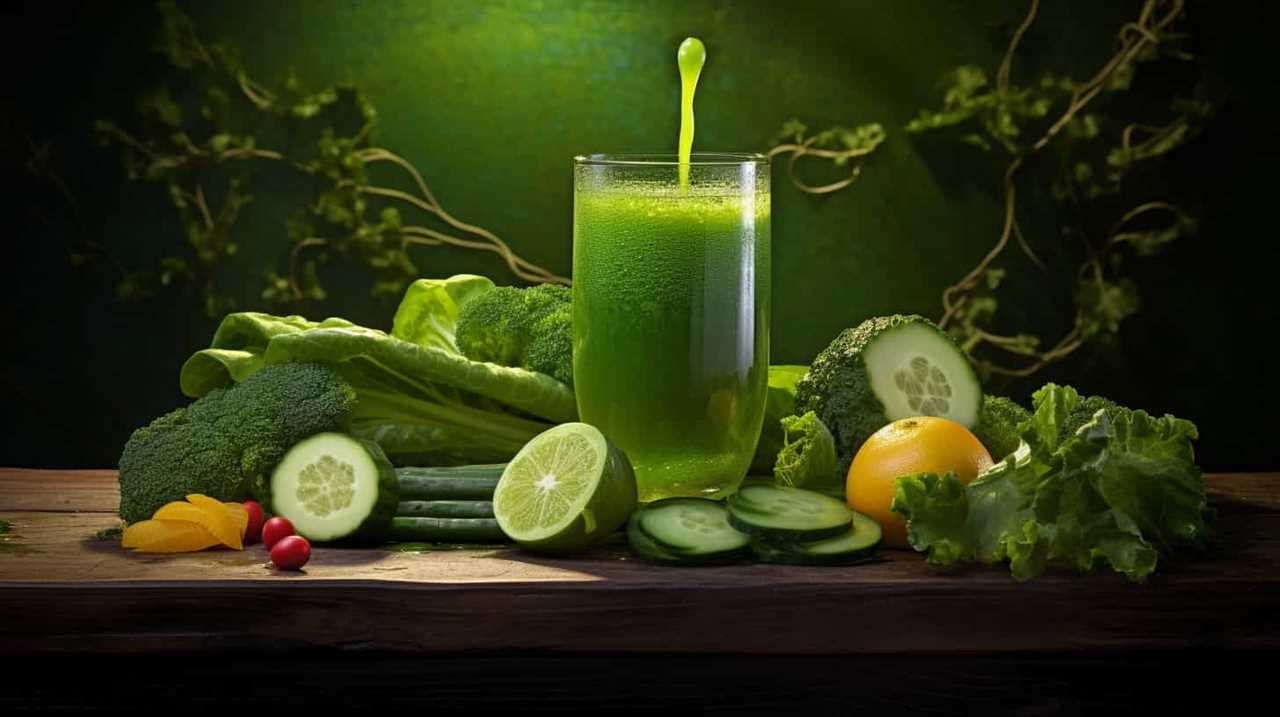
It’s important to start with the right pitcher. Look for a pitcher that’s made of glass or BPA-free plastic, as these materials won’t affect the taste of the lemonade. The pitcher should also have a lid or cover to keep the lemonade fresh and prevent spills.
Now, let’s talk about the lemons. While bottled lemon juice is convenient, using fresh lemons instead can elevate the flavor of your lemonade. Choose lemons that are firm and have a bright yellow color. Give them a gentle squeeze to ensure they’re juicy. To extract the juice, you’ll need a citrus juicer or a reamer. These tools make it easy to get every last drop of juice from the lemons.
Mixing the Lemonade Concentrate
To start mixing the lemonade concentrate, we’ll slowly pour the bottled lemon juice into the pitcher. It’s important to choose the right container for the lemonade concentrate. A pitcher with a lid or a tightly sealed container will help maintain the freshness and prevent any spills or leaks. Once the lemon juice is in the pitcher, we can move on to the next step of adding water and sweetener.
To ensure the lemonade concentrate stays fresh, it’s essential to store it properly. Keep the pitcher in the refrigerator to maintain its cool temperature and prevent any bacteria growth. If you have any leftover concentrate, transfer it to a smaller container with an airtight lid before refrigerating. This will help retain its flavor and prevent any contamination.
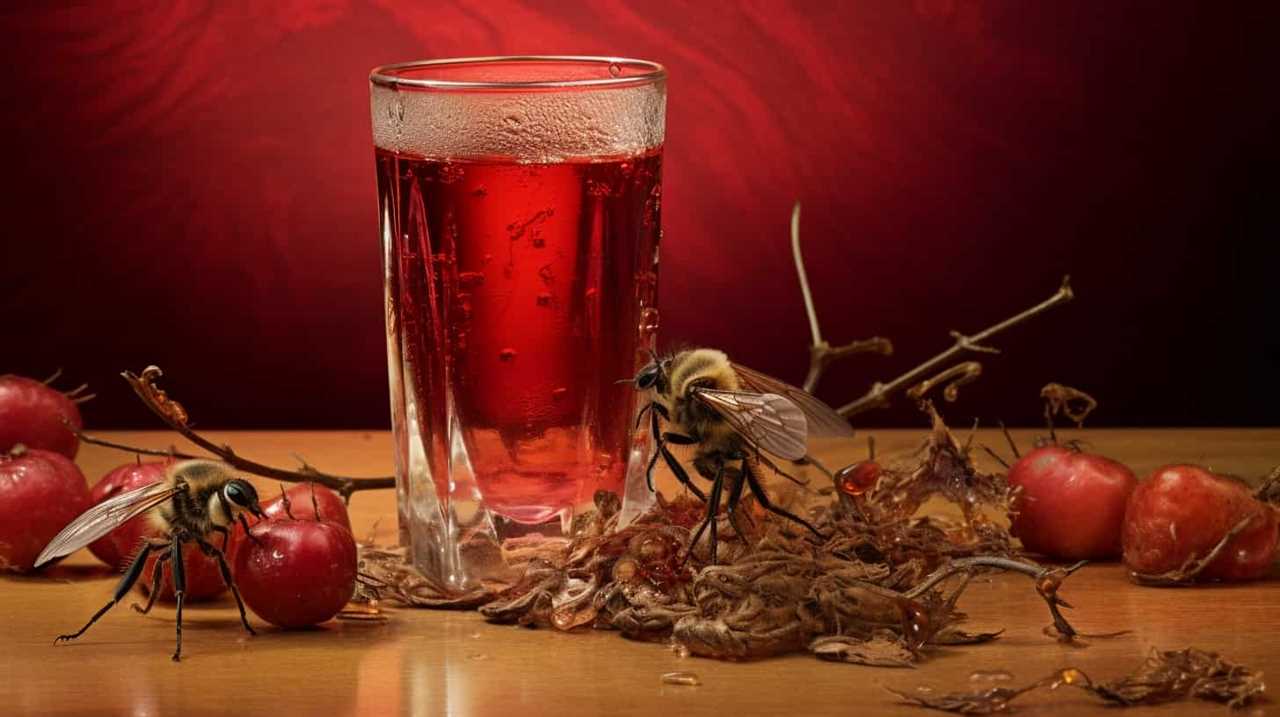
Now that we’ve mixed the lemonade concentrate, it’s time to adjust the sweetness and tartness to taste.
Adjusting the Sweetness and Tartness to Taste
We can adjust the sweetness and tartness of the lemonade to taste by adding more sugar or lemon juice, respectively. If you prefer a sweeter lemonade, simply add more sugar and stir until it dissolves completely. You can experiment with different sweeteners such as honey or agave syrup to find the perfect balance of sweetness.
On the other hand, if you want a tangier lemonade, add more lemon juice gradually, tasting as you go until it reaches your desired level of tartness.
Additionally, you can get creative with your lemonade by adding flavors like fresh mint leaves or a hint of lavender. These additions can elevate the flavor profile and create a more refreshing and unique experience.

Now that we’ve adjusted the sweetness and tartness of our lemonade, let’s move on to serving and enjoying your refreshing glass of lemonade.
Serving and Enjoying Your Refreshing Glass of Lemonade
Now let’s sit back, relax, and savor our refreshing glass of lemonade.
When it comes to serving and enjoying this delightful drink, there are a few techniques and garnishing options to consider.
Firstly, serving your lemonade chilled is essential for maximum enjoyment. Ensure that you have chilled glasses or add ice cubes to the glasses before pouring the lemonade.

To add a touch of elegance, you can garnish your lemonade with a slice of lemon on the rim of the glass. For an extra burst of flavor, you could also add a sprig of fresh mint or a few berries.
Remember to gently stir the lemonade before serving to evenly distribute the flavors.
Now, take a sip, feel the refreshing tang of lemon, and let the sweet and tart flavors dance on your taste buds.
Cheers!

Frequently Asked Questions
Can I Use Fresh Lemons Instead of Bottled Lemon Juice?
Fresh lemons offer numerous benefits over bottled lemon juice. The taste of fresh lemons is unparalleled, providing a vibrant and tangy flavor. Incorporating fresh lemons into your lemonade will elevate its taste and give it a refreshing and authentic twist.
Can I Substitute Sugar With a Different Sweetener?
Substituting sweeteners in lemonade can enhance the flavor and offer health benefits. We’re knowledgeable about alternative sweeteners and can provide precise, detailed instructions on using them in place of sugar.
How Long Does the Lemonade Concentrate Need to Chill in the Refrigerator?
The chilling time for the lemonade concentrate in the refrigerator is typically around 1-2 hours. Using bottled lemon juice offers the benefit of convenience and consistent flavor for a refreshing glass of lemonade.
Can I Add Other Fruits or Flavors to the Lemonade?
Sure, we can definitely add different fruits or flavors to our lemonade. It’s a great way to experiment with unique flavors and create refreshing, personalized drinks. The possibilities are endless!

How Long Does the Lemonade Stay Fresh in the Refrigerator?
Lemonade made with bottled lemon juice can stay fresh in the refrigerator for about 5-7 days. To maximize shelf life, store it in an airtight container and keep it chilled.
Conclusion
And so, with a few simple steps and the right ingredients, a glass of refreshing lemonade is born.
Like a symphony of flavors dancing on your taste buds, this tangy elixir quenches thirst and brings joy on a hot summer day.
Just a sip transports you to a world of citrusy delight, where the sweetness and tartness blend harmoniously.

So go ahead, indulge in the art of lemonade-making and savor every drop of this sun-kissed nectar.
Cheers to the perfect glass of lemonade!
Susannah expertise lies in researching and compiling evidence-based content on juicing, nutrition, and overall health. She is committed to ensuring that The Juicery World offers accurate, up-to-date, and trustworthy information to empower readers to take control of their health. Susannah’s goal is to inspire individuals to embrace juicing as a way to nourish their bodies and live their best lives.
Juice Tips and Tricks
How to Know if Orange Juice Is Bad

We’ve all been in that situation before – reaching for a glass of orange juice and hesitating, unsure if it’s still okay to drink. Fear not! This article will give you the knowledge you need to determine for sure if your orange juice is still fresh or if it’s gone bad.
With a blend of scientific precision and practical tips, we’ll explore color changes, strange smells, off taste, texture changes, and mold or growth that may indicate spoilage.
Let’s dive in and serve ourselves a refreshing glass of certainty!
Key Takeaways
- Color changes in orange juice can indicate a loss of freshness and shelf life extension, but it doesn’t necessarily mean the juice is bad.
- Unusual or off-putting odors in orange juice, such as sour or fermented scents, can be a sign of poor quality.
- An off taste in orange juice, such as sour, bitter, or fermented flavors, suggests that the juice is spoiled.
- Texture changes in orange juice, such as pulp separation or a thicker consistency, can occur as the juice ages, so it’s important to consume it before the expiration date.
Color Changes in Orange Juice
We should be aware that color changes can indicate whether orange juice is bad.

When it comes to orange juice, color is a crucial factor to consider. As oranges are exposed to air, an oxidation process occurs, which leads to changes in color. Fresh orange juice has a vibrant orange hue, indicating its freshness and high nutritional value.
However, as time passes, the juice may undergo a color change, turning dull or brownish. This change in color is a result of the oxidation process, which affects the flavor and quality of the juice. It’s important to note that while a change in color doesn’t necessarily mean the juice is bad, it does indicate that the juice is losing its freshness and shelf life extension.
Therefore, it’s advisable to consume orange juice when it’s at its freshest, as indicated by its vibrant orange color.
Strange Smells in Orange Juice
When it comes to evaluating orange juice, we should be cautious of any strange smells or odors. A fresh, pleasant smell is indicative of good quality orange juice. However, if you notice any unusual or off-putting odors, it may be a sign that the juice has gone bad. These smells can range from a sour or fermented scent to a rancid or moldy aroma.

It’s important to note that while some natural variations in scent can occur due to the specific variety of oranges used, any strong or unpleasant smells should raise concerns. If you have citrus fruit allergies, it’s especially important to pay attention to the smell of orange juice, as it could indicate the presence of spoilage or contamination.
Ensuring the quality of orange juice is essential as it’s a popular beverage known for its health benefits, including being rich in vitamin C and antioxidants.
Off Taste of Orange Juice
Our taste buds can detect even the slightest hint of an off taste in orange juice, which can indicate that it has gone bad. The taste of orange juice should be fresh, tangy, and slightly sweet. If it tastes sour, bitter, or fermented, it’s likely spoiled.
One common cause of an off taste in orange juice is the use of overripe oranges. When oranges become overripe, their flavor profile changes, resulting in a less pleasant taste. Another factor to consider is the expiration date. Orange juice that has passed its expiration date is more likely to develop an off taste. It’s important to check the expiration date before consuming orange juice to ensure its freshness and quality. Additionally, improper storage conditions, such as leaving the juice at room temperature for extended periods, can lead to the development of unpleasant flavors. Storing orange juice in the refrigerator helps maintain its freshness for longer. For those exploring different juice options, aloe vera juice flavor tips suggest pairing tart juices with milder flavors to balance the overall taste.
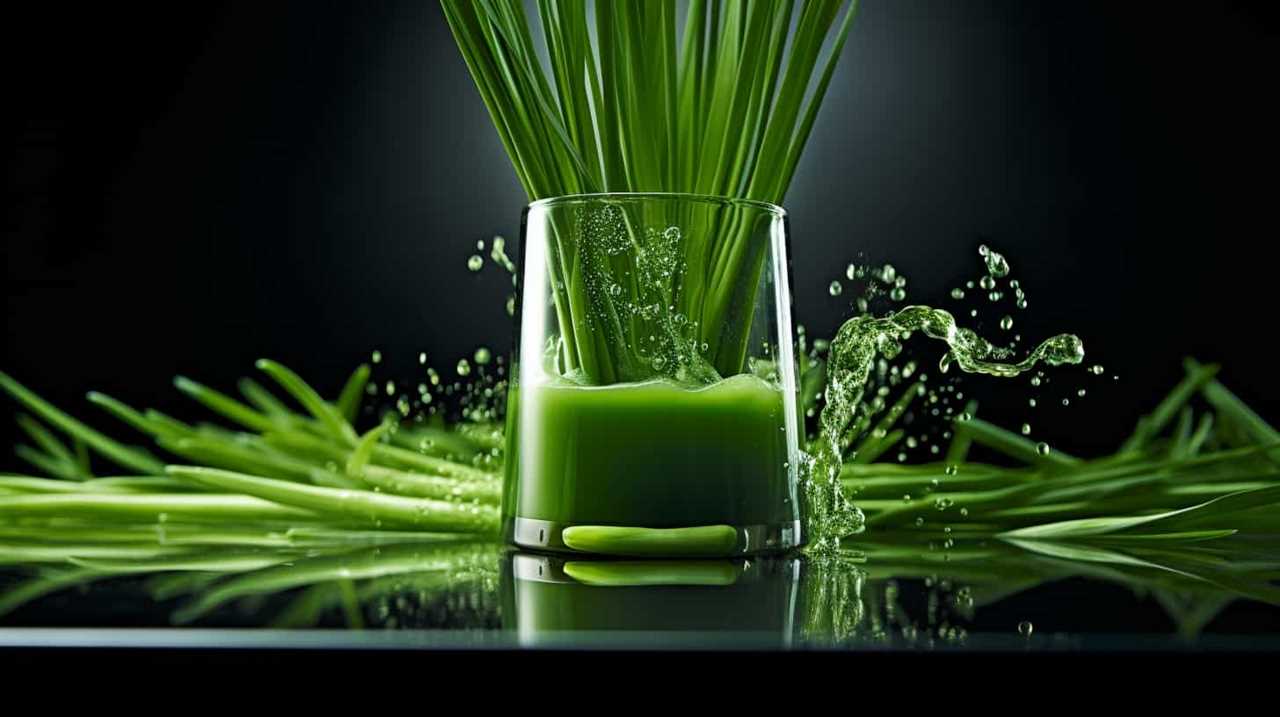
Now, let’s move on to discuss the texture changes in orange juice.
Texture Changes in Orange Juice
As we explore the texture changes in orange juice, it’s important to note that certain factors can cause it to become thicker or develop sediment. One common texture change in orange juice is pulp separation, where the pulp separates from the liquid and settles at the bottom. This can occur naturally over time, as the pulp particles become denser and sink.
Another factor that can affect the texture of orange juice is the expiration date. As orange juice ages, it may start to develop a thicker consistency and even form sediment. This is a result of the natural breakdown of the juice’s components. Therefore, it’s crucial to check the expiration date on orange juice and consume it before it reaches its expiration date to avoid any undesirable texture changes.
Mold or Growth in Orange Juice
We need to be aware of the possibility of mold or other growth occurring in orange juice. Mold can develop in orange juice if it isn’t stored properly or if it has passed its expiration date.

To prevent mold growth, it’s important to follow these steps:
- Store orange juice in the refrigerator at a temperature below 40°F (4°C).
- Check the expiration date on the bottle before consuming. Discard any orange juice that has expired.
- Keep the container tightly sealed to prevent air and moisture from entering, as these can promote mold growth.
Regularly inspecting orange juice for any signs of mold or unusual growth is essential. If you notice any discoloration, a strange odor, or visible mold, it’s best to discard the juice to avoid any potential health risks.
Frequently Asked Questions
Can Orange Juice Go Bad if It’s Stored in the Freezer for Too Long?
Frozen orange juice can potentially lose its nutrients and change its taste if stored in the freezer for too long. It is important to check for signs of spoilage before consuming it.
How Long Can Orange Juice Stay Fresh in the Refrigerator Once It’s Opened?
Once opened, orange juice can stay fresh in the refrigerator for about 7-10 days. To maintain its freshness, store it properly by keeping it tightly sealed and at a consistently cold temperature. If the orange juice develops an off odor, flavor, or appearance, it’s best to discard it to avoid any potential health risks. Factors like exposure to air and varying temperatures can influence how long orange juice lasts, so it’s crucial to handle it with care. Always check the expiration date as a general guide, but remember that proper storage can extend its freshness slightly. Additionally, avoid leaving the orange juice out at room temperature for extended periods, as this can significantly shorten how long orange juice lasts. Freezing the juice can be another option to extend its shelf life, but be aware that this may alter its texture and taste once thawed. By following these precautions, you can ensure your orange juice stays fresh and safe to consume.
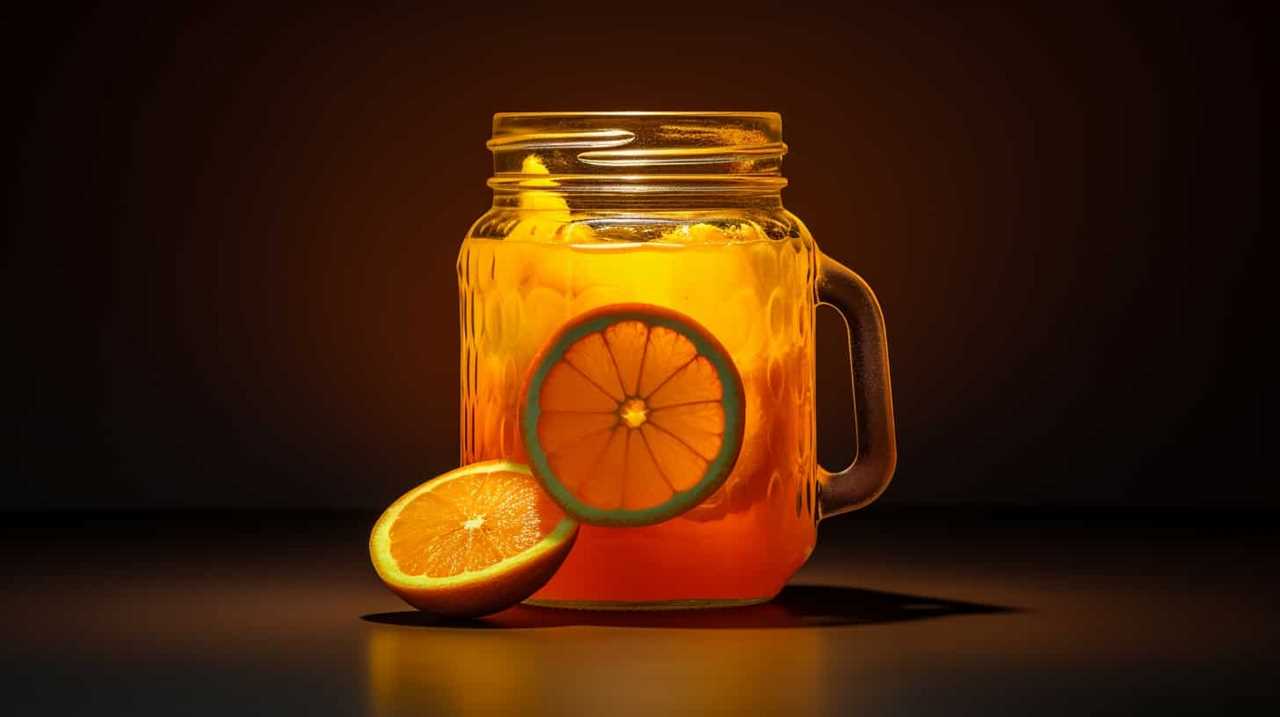
Is It Safe to Consume Orange Juice That Has Been Left Out at Room Temperature Overnight?
Left out orange juice may not be safe to drink as it can harbor harmful bacteria. Signs of spoiled orange juice include a sour smell, mold growth, and a change in color or taste.
Can Orange Juice Develop Harmful Bacteria if It’s Past Its Expiration Date but Still Looks and Smells Fine?
Orange juice can cause food poisoning if it develops harmful bacteria, even if it looks and smells fine. Signs of spoiled orange juice include a sour smell, mold growth, and a change in color or taste.
Does the Nutritional Value of Orange Juice Decrease as It Starts to Go Bad?
As orange juice goes bad, its nutritional value decreases. The longer it sits on the shelf, the more nutrients it loses. Signs of spoilage include a sour smell, off taste, and mold growth.
Conclusion
In conclusion, determining if orange juice is bad requires careful observation of color changes, strange smells, off taste, and texture changes. Just like a detective investigating a case, we must rely on our senses to detect any signs of spoilage.
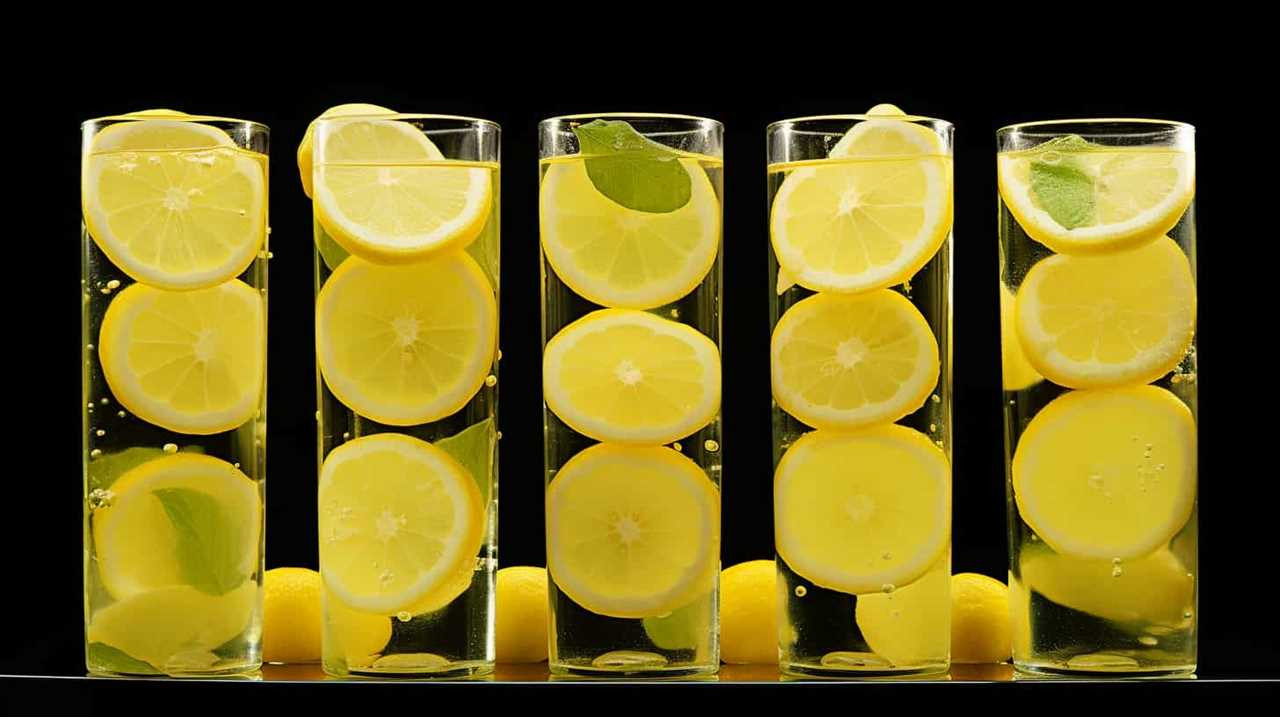
If we detect mold or growth in the orange juice, it’s a clear indication that it’s no longer safe to consume. By remaining vigilant and attuned to these indicators, we can ensure that our orange juice is always fresh and enjoyable.
Susannah expertise lies in researching and compiling evidence-based content on juicing, nutrition, and overall health. She is committed to ensuring that The Juicery World offers accurate, up-to-date, and trustworthy information to empower readers to take control of their health. Susannah’s goal is to inspire individuals to embrace juicing as a way to nourish their bodies and live their best lives.
-

 Vetted2 months ago
Vetted2 months ago15 Best Juices for Diabetics: Refreshing Options That Won’t Spike Your Blood Sugar
-

 Vetted2 months ago
Vetted2 months ago15 Best Decaf Coffee Options for Flavor Lovers Who Need a Caffeine Break
-

 Vetted2 months ago
Vetted2 months ago15 Best Espresso Ground Coffees to Elevate Your Morning Brew
-

 Vetted2 months ago
Vetted2 months ago15 Best K-Cup Coffee Pods for a Perfect Brew Every Time
-

 Vetted2 months ago
Vetted2 months ago15 Best Beans for Espresso: A Guide to Perfecting Your Brew
-

 Vetted2 months ago
Vetted2 months ago15 Best Inexpensive Espresso Machines That Brew Quality Coffee on a Budget
-

 Vetted2 months ago
Vetted2 months ago15 Best Kona Coffees to Savor the Rich Flavors of Hawaii
-

 Vetted2 months ago
Vetted2 months ago15 Best Cold Brew Coffees to Keep You Refreshed All Summer Long
































